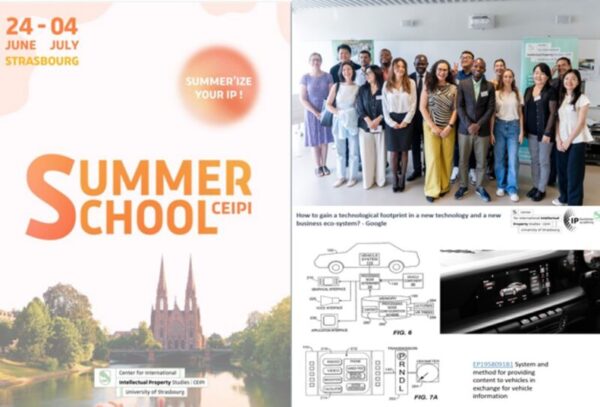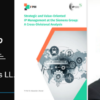IP Management Excellence: Insights from the CEIPI Summer School 2025
The CEIPI Summer School 2025 once again brought together IP experts, scholars and industry practitioners to discuss cutting-edge trends in intellectual property management. Hosted by the Center for International Intellectual Property Studies (CEIPI) in Strasbourg, this year’s program focused on a pressing question that resonates with innovators and IP managers alike: How can IP strategies evolve in a digital, data-driven and increasingly interconnected world?
This year’s lecture, delivered by Prof. Dr. Alexander J. Wurzer, dived deep into the changing landscape of digital patents, the increasing complexity of technology ecosystems and how companies can secure lasting competitive advantage through well-structured and value-driven IP strategies.
IP Business Academy as a European Hub for IP Excellence
CEIPI, as part of the University of Strasbourg’s law faculty, remains the central European hub for training patent attorneys and IP managers. The IP Business Academy, the part of CEIPI deals with IP management with over 18.000 hours of lecturing in its educational. IP Business Academy continues to shape Europe’s IP landscape working with IP subject matter experts globally:
👉 https://ipbusinessacademy.org/ip-subject-matter-expert
Its role as a think tank, an education platform and a bridge between academia and industry is vital as the pace of innovation accelerates and the demand for well-trained IP professionals grows.
The Rise of Digital Patent Applications
A key highlight from the lecture was the dramatic increase in digital patent applications in recent years. The European Patent Office (EPO) study cited by Prof. Wurzer reveals a sharp rise in Industry 4.0-related filings, with 54 percent growth within three years. This trend illustrates how deeply digital technologies such as AI, quantum computing and machine learning have permeated nearly every industry.
However, these technologies do not simply add new technical layers — they reshape entire markets, user experiences and business models. For IP managers, this creates new challenges. Traditional patent strategies are often too narrow to address the complex interdependencies of digital ecosystems. Today, securing a single patent is rarely enough. It is about crafting layered, connected strategies that protect not only inventions but also user experiences, data flows and business processes.
Business-Driven IP Strategies: A New Imperative
One of the central messages of the presentation was that business must take the lead when shaping IP strategies for digital transformation. Drawing on insights from industry leaders like Beat Weibel and Rudolf Freytag of Siemens, Prof. Wurzer emphasized that IP can no longer be treated as a purely legal instrument. Instead, it must align directly with business objectives and be embedded in every phase of the value chain.
For example, new enabling technologies such as 5G and 6G, virtual and augmented reality or AI-assisted systems multiply the ways companies create and deliver value. IP strategies must now reflect the fact that these technologies often support platform-based and transaction-driven business models that rely heavily on data integration and user-centric services.
Top-Down and Bottom-Up Protection of Use Cases
Prof. Wurzer illustrated these ideas with practical case studies, starting with a discussion of how companies protect digital use cases through both top-down and bottom-up approaches. In a top-down approach, businesses identify core strategic objectives first, then build technological solutions and secure them through patents and other IP rights. The bottom-up perspective begins with specific use cases and user needs, using IP to protect these at the grassroots level before scaling up.
Two well-known examples demonstrate these contrasting but complementary methods: Spotify and Sonos.
Spotify, for example, has become a global leader in music streaming not only by offering a massive audio library but by creating a unique digital experience. Its IP portfolio protects personalized playlist algorithms and user interface innovations. One patent, US10540385B2, covers taste profile attributes that personalize music recommendations, an essential part of Spotify’s promise to deliver music anytime, anywhere with maximum relevance. Here, the company shows how protecting the user experience directly supports its subscription and ad-based revenue models.
Sonos, on the other hand, illustrates how product-focused innovation drives value. Its patents, such as US8588949B2, protect smart audio systems that automate volume levels across multi-room setups. For Sonos, the business case is hardware sales, but the embedded digital experience ensures customer loyalty and justifies premium pricing.
Building Technological Footprints: The Google Case
How can companies break into entirely new technological fields and business ecosystems? Google’s approach provides one answer. Prof. Wurzer highlighted Google’s early moves in connected vehicles and AI-powered voice assistants. By securing foundational patents like EP1958091B1 for delivering content to vehicles in exchange for data, Google established a position within the automotive sector’s evolving data economy.
Similarly, patents like EP4158621B1 for enabling natural conversations with virtual assistants demonstrate how Google embedded itself in the voice assistant ecosystem long before it became mainstream. These moves illustrate how IP can act as a strategic tool to shape emerging market spaces and safeguard technological beachheads.
👉 Digital IP lexicon dIPlex deep dive on IP in the digital transformation
Niche vs. Mass Market: Rolex and Casio
Prof. Wurzer also contrasted luxury brand strategies with mass-market approaches through the lens of watchmakers Rolex and Casio. Rolex exemplifies a niche strategy with carefully crafted brand positioning and design protection. Its design registration for the YACHT MASTER line (000708227-0006) reinforces its image as a luxury symbol associated with success.
In contrast, Casio targets the broad market with affordable, durable products like its G-Shock line. Trademarks like SHOCK RESIST (018105586) highlight how Casio’s IP supports value-focused branding and reaches diverse consumer segments. Here, IP strategy must align with high-volume production and wide distribution rather than exclusivity.
👉 Rolex and Casio case at the IP management letters
Innovation in Lighting: Philips Signify and the Role of R&D
The presentation also explored how IP strategies evolve alongside changing industry contexts. The transformation of Philips’ lighting division into Signify shows how R&D and IP can reshape entire industries. Historically, Philips invested heavily in LED innovations and aggressively defended its patents through litigation and cross-licensing.
Over time, this evolved into the EnabLED licensing program, which now includes more than 1,000 licensees. Signify’s shift from selling light bulbs to offering “light as a service” demonstrates how IP can support entirely new business models. Patents like US9572227B2, which protects intelligent lighting networks, illustrate how Signify moves beyond products to deliver connected experiences that are integrated into smart city and IoT ecosystems.
👉 Case study Signify and its IP strategy
The Power of Layered IP Strategies: Danone’s Probiotic Success
Another standout example was Danone’s layered IP strategy in the functional foods sector. Functional foods like probiotic yogurt provide health benefits beyond basic nutrition, appealing to consumers seeking preventive healthcare. Danone’s approach demonstrates how companies can protect not only product formulas but also the processes, branding and consumer behaviors that support long-term market leadership.
Danone’s patents cover over 4,000 proprietary bacterial strains. Trademarks like Activia and Actimel convert scientific credibility into daily routines for millions of consumers. Trade secrets protect unique fermentation processes, while copyrights and design rights secure packaging innovations that distinguish Danone’s products on crowded supermarket shelves. Behavioral IP, such as the “Gut Health Tracker” app, locks in consumer loyalty by integrating consumption into daily wellness habits.
IoT Innovation in Action: Husqvarna and Telenor
Husqvarna, in collaboration with Telenor, represents another powerful case of how a holistic IP strategy supports digital transformation. The company’s Automower NERA robotic lawnmower integrates multi-sensor mapping technology, remote control and weather-adaptive features to create an autonomous, smart lawn care solution. Patents like EP3234721B1 protect this core technology.
Husqvarna’s IP strategy covers hardware, software and connectivity, creating robust protection across its IoT ecosystem. Collaborating with Telenor ensures secure, reliable connectivity, strengthening the offering and differentiating Husqvarna in a market increasingly crowded by smart home solutions.
👉 Glossary entry interoperability
Digital Payments: Stripe’s API Revolution
Stripe demonstrates how digital platforms can transform traditional industries through well-designed IP portfolios. Its simple yet powerful API removes barriers for developers who want to integrate payment processing into websites or apps. By covering its privacy-preserving fraud detection systems with patents like US12205119B2, Stripe ensures that its core technology remains protected while enabling rapid scaling.
Harnessing Open Innovation: LEGO’s Balancing Act
Finally, Prof. Wurzer’s lecture examined how companies can invite external innovation while safeguarding core IP. LEGO’s Mindstorms platform is a classic case. By allowing enthusiasts to modify and expand its programmable kits, LEGO unlocked a community of co-creators. However, it carefully balances openness with protection. Standardized legal agreements clarify IP ownership, platform-level patents secure the core technology and strict trademark enforcement maintains brand integrity.
User Experience as IP: Spotify’s Color Psychology
Spotify’s color psychology strategy shows that user experience itself can be a protectable asset. By aligning visual design with listening behavior and mood, Spotify uses color as a storytelling tool. UX patents, such as US10148789B2 and US9798514B2, protect methods for personalizing user experiences and visualizing beats through color. This ensures competitors cannot easily replicate the emotional engagement that keeps Spotify’s listeners loyal.
Concluding Thoughts: IP Management in a Complex World
The CEIPI Summer School 2025 made it clear that modern IP management is no longer just about protecting isolated inventions. The future belongs to layered, adaptive and business-driven IP strategies that span technologies, customer experiences and ecosystems.
Today’s leaders in IP strategy think beyond patents. They protect user experiences, secure behavioral data, build trusted brands and partner smartly to expand their technological footprint. As industries digitize and data becomes a core asset, the skills and insights shared at CEIPI will remain crucial for the next generation of IP professionals tasked with safeguarding Europe’s innovation potential.
For anyone navigating this landscape, the message is clear: IP excellence is not a legal silo but a dynamic tool for strategic growth. The case studies from Spotify, Google, LEGO, Stripe, Danone, Husqvarna, Philips and more demonstrate how the right mix of legal protection, business insight and technological vision can turn ideas into market leadership. The future of IP belongs to those ready to think holistically, collaborate widely and protect value where it truly lies — at the intersection of technology, business and the customer experience.



